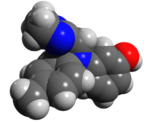Phentolamine
 |
|
 |
|
| Clinical data | |
|---|---|
| Trade names | Regitine |
| AHFS/Drugs.com | Micromedex Detailed Consumer Information |
| Pregnancy category |
|
| Routes of administration |
Usually IV or IM |
| ATC code | C04AB01 (WHO) V03AB36 (WHO) |
| Legal status | |
| Legal status |
|
| Pharmacokinetic data | |
| Metabolism | Liver |
| Biological half-life | 19 minutes |
| Identifiers | |
|
|
| CAS Number |
50-60-2 |
| PubChem (CID) | 5775 |
| IUPHAR/BPS | 502 |
| DrugBank |
DB00692 |
| ChemSpider |
5571 |
| UNII |
Z468598HBV |
| KEGG |
D08362 |
| ChEBI |
CHEBI:8081 |
| ChEMBL |
CHEMBL597 |
| ECHA InfoCard | 100.000.049 |
| Chemical and physical data | |
| Formula | C17H19N3O |
| Molar mass | 281.352 g/mol |
| 3D model (Jmol) | Interactive image |
|
|
|
|
|
|
|
Phentolamine (Regitine) is a reversible nonselective α-adrenergic antagonist.
Its primary action is vasodilation due to α1 blockade.
Non-selective α-blockers can cause a much more pronounced reflex tachycardia than the selective α1 blockers. Like the selective α1 blockers, phentolamine causes a relaxation of systemic vasculature, leading to hypotension. This hypotension is sensed by the baroreceptor reflex, which results in increased sympathetic nerve firing on the heart, releasing norepinephrine. In response, the β1 adrenergic receptors on the heart increase its rate, contractility, and dromotropy, which help to offset the decrease in systemic blood pressure. Unlike the α1 selective blockers, phentolamine also inhibits the α2 receptors, which function predominantly as presynaptic negative feedback for norepinephrine release. By abolishing this negative feedback phentolamine leads to even less regulated norepinephrine release, which results in a more drastic increase in heart rate.
The primary application for phentolamine is for the control of hypertensive emergencies, most notably due to pheochromocytoma.
It also has usefulness in the treatment of cocaine-induced cardiovascular complications, where one would generally avoid β-blockers (e.g. metoprolol), as they can cause unopposed α-adrenergic mediated coronary vasoconstriction, worsening myocardial ischemia and hypertension. It is important to note that phentolamine is not a first-line agent for this indication. Phentolamine should only be given to patients who do not fully respond to benzodiazepines, nitroglycerin, and calcium channel blockers.
...
Wikipedia
